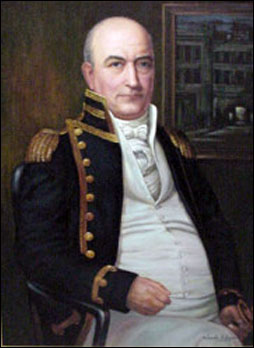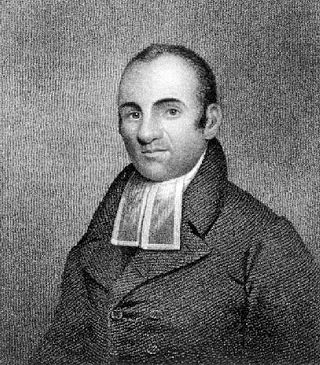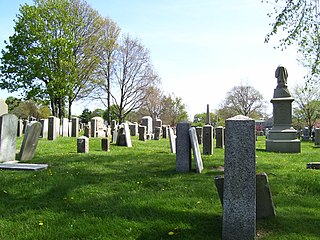
Israel Putnam, popularly known as "Old Put", was an American military officer and landowner who fought with distinction at the Battle of Bunker Hill during the American Revolutionary War (1775–1783). He also served as an officer with Rogers' Rangers during the French and Indian War (1754–1763), when he was captured by Mohawk warriors. He was saved from the ritual burning given to enemies by the intervention of French officer Molang, with whom the Mohawks were allied. Putnam's courage and fighting spirit became known far beyond his home of Connecticut's borders through the circulation of folk legends in the American colonies and states celebrating his exploits.

Lebanon is a town in New London County, Connecticut, United States. The town is part of the Southeastern Connecticut Planning Region. The population was 7,142 at the 2020 census. The town lies just to the northwest of Norwich, directly south of Willimantic, 20 miles (32 km) north of New London, and 20 miles (32 km) east of Hartford. It is best known for its role in the American Revolution, when it was a major base of American operations, and for its historic town green, which is one of the largest in the nation and the only one still used partially for agriculture.

Manumission, or enfranchisement, is the act of freeing slaves by their owners. Different approaches to manumission were developed, each specific to the time and place of a particular society. Historian Verene Shepherd states that the most widely used term is gratuitous manumission, "the conferment of freedom on the enslaved by enslavers before the end of the slave system".

Roger Sherman was an early American statesman, lawyer, and a Founding Father of the United States. He is the only person to sign all four great state papers of the United States: the Continental Association, the Declaration of Independence, the Articles of Confederation, and the Constitution. He also signed the 1774 Petition to the King.

The Sons of Liberty was a loosely organized, clandestine, sometimes violent, political organization active in the Thirteen American Colonies founded to advance the rights of the colonists and to fight taxation by the British government. It played a major role in most colonies in battling the Stamp Act in 1765 and throughout the entire period of the American Revolution. Historian David C. Rapoport called the activities of the Sons of Liberty "mob terror."

Captain Silas Talbot was an American military officer and slave trader. He served in the Continental Army and Continental Navy during the American Revolutionary War, and is most famous for commanding USS Constitution from 1799 to 1801. Talbot was a member of the Society of the Cincinnati's New York branch.

Joseph Warren, a Founding Father of the United States, was an American physician who was one of the most important figures in the Patriot movement in Boston during the early days of the American Revolution, eventually serving as President of the revolutionary Massachusetts Provincial Congress. Warren enlisted Paul Revere and William Dawes on April 18, 1775, to leave Boston and spread the alarm that the British garrison in Boston was setting out to raid the town of Concord and arrest rebel leaders John Hancock and Samuel Adams. Warren participated in the Battles of Lexington and Concord the following day, the opening engagements of the American Revolutionary War.

Joseph Plumb Martin was a soldier in the Connecticut Militia and Continental Army during the American Revolutionary War, and was mustered out as a 23-year-old Sergeant in a Sapper company. His published narrative of his experiences, re-discovered in the 1950s, has become a valuable resource for historians in understanding the conditions of a common soldier of that era, as well as the battles in which Martin participated.

Thomas Tingey was a commodore of the United States Navy. Originally serving in the British Royal Navy, Tingey later served in the Continental Navy. Tingey served with distinction during the Quasi-War and served as the commandant of the navy yard until his death.

Lemuel Haynes was an American clergyman. A veteran of the American Revolution, Haynes was the first black man in the United States to be ordained as a minister.
Prince Whipple was an African American slave and later freedman. He was a soldier and a bodyguard during the American Revolution under his slaveowner General William Whipple of the New Hampshire Militia who formally manumitted him in 1784. Prince is depicted in Emanuel Leutze's painting Washington Crossing the Delaware and Thomas Sully's painting Passage of the Delaware.
Peter Salem was an African-American from Massachusetts who served as a U.S. soldier in the American Revolutionary War. Born into slavery in Framingham, he was freed by a later master, Major Lawson Buckminster, to serve in the local militia. He then enlisted in the Continental Army, serving for nearly five years during the war. Afterwards, he married and worked as a cane weaver. A monument was erected to him in the late 19th century at his grave in Framingham.

Nero Hawley was an African-American soldier who was born into slavery in North Stratford, Connecticut, and later earned his freedom after enlisting in the Continental Army in place of his owner, Daniel Hawley, on April 20, 1777, during the American Revolution. His life is featured in the 1976 book From Valley Forge to Freedom, which also notes other areas of present-day Trumbull, Connecticut associated with Hawley.

African Americans fought on both sides the American Revolution, the Patriot cause for independence as well as in the British army, in order to achieve their freedom from enslavement. It is estimated that 20,000 African Americans joined the British cause, which promised freedom to enslaved people, as Black Loyalists. About half that number, an estimated 9,000 African Americans, became Black Patriots.

Black Patriots were African Americans who sided with the colonists who opposed British rule during the American Revolution. The term Black Patriots includes, but is not limited to, the 5,000 or more African Americans who served in the Continental Army and Patriot militias during the American Revolutionary War.

The Common Burying Ground and Island Cemetery are a pair of separate cemeteries on Farewell and Warner Street in Newport, Rhode Island. Together they contain over 5,000 graves, including a colonial-era slave cemetery and Jewish graves. The pair of cemeteries was added to the National Register of Historic Places as a single listing in 1974.
Titus Gay, who called himself Titus Kent, also known as "Old Ti", was born into slavery in the town of Suffield, Connecticut, United States. Titus's father had the Kent surname. Because of the Gradual Emancipation Act passed in 1784, Titus was freed in 1812. Once freed, he continued to work for Rev. Ebenezar Gay, Jr. performing a number of duties. His presence in the lives of the townspeople made him an important member of the community. He is also remembered for his efforts to prevent local enslaved people from being sent into slavery in the South. He was buried in the Congregational church cemetery in Suffield, Connecticut.
Primus Hall was born into slavery. He is believed to be the son of Prince Hall, an abolitionist, American Revolutionary War soldier and founder of the Prince Hall Freemasonry.
John Ely was a Connecticut surgeon and Colonel in the American Revolution.













